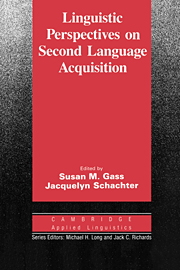Book contents
- Frontmatter
- Contents
- List of contributors
- Series editors' preface
- Introduction
- I THEORIES OF ACQUISITION
- II SYNTAX
- Chapter 3 Testing a proposed universal
- Chapter 4 The role of the head-initial/head-final parameter in the acquisition of English relative clauses by adult Spanish and Japanese speakers
- Chapter 5 On some properties of the “pro-drop” parameter: looking for missing subjects in non-native Spanish
- Chapter 6 The adjacency condition on case assignment: do L2 learners observe the Subset Principle?
- III SEMANTICS/PRAGMATICS
- IV LEXICON
- V PHONOLOGY
- Index
Chapter 6 - The adjacency condition on case assignment: do L2 learners observe the Subset Principle?
Published online by Cambridge University Press: 05 October 2012
- Frontmatter
- Contents
- List of contributors
- Series editors' preface
- Introduction
- I THEORIES OF ACQUISITION
- II SYNTAX
- Chapter 3 Testing a proposed universal
- Chapter 4 The role of the head-initial/head-final parameter in the acquisition of English relative clauses by adult Spanish and Japanese speakers
- Chapter 5 On some properties of the “pro-drop” parameter: looking for missing subjects in non-native Spanish
- Chapter 6 The adjacency condition on case assignment: do L2 learners observe the Subset Principle?
- III SEMANTICS/PRAGMATICS
- IV LEXICON
- V PHONOLOGY
- Index
Summary
Since its inception, generative grammar has had two main aims. One is to devise grammars which characterize the ideal speaker-hearer's competence, the underlying system of rules which has been internalized. In other words, the grammars that linguists propose are assumed to have psychological reality. The second aim, which has taken precedence over the first one in recent years, is to provide not only a description of what it is that native speakers unconsciously know about their language but at the same time to explain how they come by this knowledge, to answer the so-called logical problem of language acquisition. Many properties of human languages are extremely complex and subtle, and it is argued that language learners discover such complexities by means of innate linguistic structure, or Universal Grammar (UG).
This innate language component is largely motivated by arguments concerning the poverty of the stimulus. Certain shortcomings in the input, including the lack of negative evidence or information about ungrammatically, apparently make it impossible for the child to project the adult grammar from the input alone (Baker and McCarthy 1981; Hornstein and Lightfoot 1981). This projection problem can be overcome if the child is predisposed to deal with language input in quite restricted ways, with UG providing limitations on possible grammars. The language learner constructs a particular grammar, or a series of grammars, on the basis of UG interacting with the input data, the language that he or she hears.
- Type
- Chapter
- Information
- Linguistic Perspectives on Second Language Acquisition , pp. 134 - 158Publisher: Cambridge University PressPrint publication year: 1989
- 26
- Cited by



